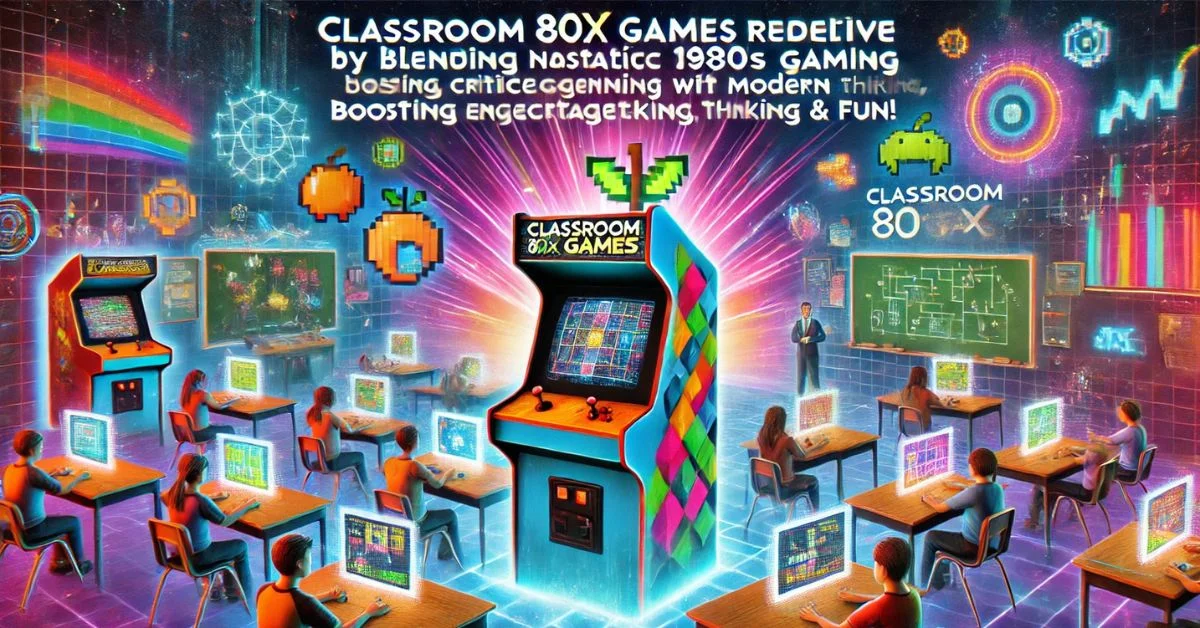In today’s fast-paced digital world, educators are continually seeking innovative ways to engage students. One method that’s making a nostalgic yet groundbreaking comeback is the integration of retro games—specifically, the Classroom 80X Games—into modern learning environments. These games, inspired by the vibrant era of the 1980s, not only evoke fond memories but also serve as powerful educational tools. In this article, we will explore how these retro games are transforming the classroom, enhancing student engagement, and fostering essential skills.
Introduction
Overview of Retro Gaming
Retro gaming brings back the charm and simplicity of early video games. Unlike today’s hyper-realistic and graphically intense games, retro games offer straightforward mechanics, pixel art aesthetics, and engaging gameplay that rely on strategy and quick thinking. These games, which once dominated arcades and home consoles, are now being reimagined for educational purposes.
The Significance of 80X Games
The term “80X Games” harks back to the golden age of gaming in the 1980s—a period when creativity was king, and simple graphics didn’t hinder immersive gameplay. These games hold a special place in pop culture and have the power to bridge generations. Today, educators are harnessing this retro appeal to make learning more interactive and fun. By incorporating elements of these classic games into the curriculum, teachers can create a more dynamic classroom atmosphere that resonates with students.
The Nostalgia Factor in Education
What is Retro Nostalgia?
Retro nostalgia is the sentimental longing for the past, where memories of simpler times evoke positive emotions. In education, nostalgia can serve as a bridge between traditional teaching methods and modern digital learning. It creates a familiar and comforting environment that can reduce anxiety and make learning more accessible.
The Cultural Impact of 80X Games
The cultural impact of Classroom 80X games cannot be overstated. These games not only provided entertainment but also introduced many to the world of problem-solving and critical thinking. They are now part of a collective memory that spans generations. Bringing these games back into the classroom taps into this shared experience, creating a communal learning journey. It’s like inviting students to step into a time machine where the past meets the present in an exciting educational adventure.
Historical Background of Classroom 80X Games
Evolution of 80X Games in the 1980s
The 1980s were a revolutionary period for gaming. With the advent of personal computers and home consoles, gaming became more accessible than ever. Developers experimented with simple yet addictive gameplay, and titles from this era set the foundation for modern video games. Many of these games featured puzzles, strategy, and action—elements that are just as relevant in today’s classrooms.
Technological Milestones
During the 1980s, technological advancements paved the way for the first wave of digital entertainment. From the introduction of 8-bit microprocessors to the rise of arcade cabinets, these milestones created a fertile ground for creative expression. Today’s educators can draw parallels between these innovations and modern technology, offering a historical perspective that enriches the learning experience.
The Role of Retro Games in Modern Classrooms
Enhancing Engagement Through Gamification
Gamification—the incorporation of game elements into non-game contexts—has emerged as a powerful strategy in modern education. Retro games, with their engaging mechanics and simple rules, are perfect for this approach. They make learning interactive and enjoyable, transforming mundane lessons into exciting challenges. Imagine a math lesson where students solve puzzles to advance levels, or a history class where timelines become interactive game boards. This method not only captures attention but also encourages active participation.
Benefits for Cognitive Development
Retro games in the classroom do more than entertain; they play a crucial role in developing cognitive skills. These games require players to think critically, plan ahead, and make quick decisions—all of which are invaluable skills in academic and real-world settings.
Critical Thinking and Problem-Solving
At the heart of many retro games is the challenge of overcoming obstacles. Whether navigating a maze or solving a puzzle, students are pushed to think outside the box. This nurtures critical thinking and problem-solving skills in a fun, non-intimidating way. When students encounter challenges in these games, they learn that failure is just a stepping stone to success—a lesson that translates well into academic learning and life in general.
Practical Integration Strategies
Case Studies and Success Stories
Many educators who have integrated retro gaming into their curricula report remarkable results. For instance, one high school in California introduced classic arcade games during its computer science classes. The result? Increased student engagement and improved problem-solving abilities. In another example, a middle school in Texas used retro games to teach history by simulating historical events through interactive gameplay. These case studies highlight how retro gaming can be a catalyst for educational innovation.
Tools and Technologies for Implementation
Integrating retro games into the classroom doesn’t require expensive equipment. There are numerous software emulators, online platforms, and even retro consoles available that can recreate the gaming experiences of the 1980s. Teachers can choose from a variety of games that align with their educational goals. Whether it’s a game that teaches mathematical logic or one that encourages creative storytelling, the options are vast and adaptable.
Some popular tools and platforms include:
- Emulators: Software that replicates old gaming systems on modern devices.
- Online Archives: Websites that host a collection of classic games available for free.
- Educational Gaming Platforms: Custom-built platforms that integrate retro gaming elements into lesson plans.
By carefully selecting the right tools, educators can create an immersive learning environment that resonates with the digital-native generation.
Overcoming Challenges
Technical and Budgetary Concerns
While the benefits of retro gaming in education are clear, there are challenges to consider. One common concern is the technical aspect—ensuring that the necessary hardware and software are available and functioning. Schools may face budgetary constraints when it comes to acquiring or maintaining retro gaming systems. However, many solutions are available that are both affordable and efficient. Open-source software, free emulators, and second-hand consoles can bridge the gap between limited resources and high-quality educational content.
Balancing Traditional and Digital Learning
Integrating retro games into the curriculum requires a delicate balance. It’s essential to blend traditional teaching methods with digital learning experiences to avoid over-reliance on technology. Teachers must design lesson plans that incorporate retro gaming as a complementary tool rather than a complete overhaul of the existing system. This balance ensures that the core educational objectives remain intact while still benefiting from the interactive and engaging nature of retro games.
Future Perspectives
Emerging Trends in Retro Gaming Education
As technology continues to evolve, so too do the ways in which retro games can be utilized in education. Emerging trends include the use of virtual reality (VR) to recreate retro gaming environments, offering students an immersive experience that blurs the line between past and present. Additionally, augmented reality (AR) is being explored to overlay historical gaming content onto modern classroom settings, making history come alive in ways that were previously unimaginable.
The growing interest in STEAM (Science, Technology, Engineering, Arts, and Mathematics) education is also paving the way for more creative uses of retro games. By integrating elements of art and design into the development of retro gaming projects, students can explore interdisciplinary learning that fosters both technical and creative skills.
Staying Ahead in the Digital Classroom
For educators looking to stay ahead of the curve, it’s crucial to remain informed about the latest developments in educational technology. Professional development workshops, online courses, and collaborative teacher networks can provide valuable insights into how retro gaming can be effectively integrated into the classroom. As the digital landscape continues to evolve, the key to success lies in adaptability and a willingness to embrace innovative teaching methods.
Conclusion
The integration of Classroom 80X Games into modern learning environments is more than just a trend—it’s a dynamic educational strategy that harnesses the power of nostalgia to create engaging and effective learning experiences. By reviving the charm of retro gaming, educators are not only making lessons more enjoyable but also equipping students with critical thinking and problem-solving skills that are essential for success in the modern world.
Retro games, with their simple yet captivating gameplay, remind us that learning can be fun. They offer a unique blend of historical context, technological innovation, and cultural significance that enriches the educational experience. As we look to the future, the continued evolution of retro gaming in education promises to open new avenues for creativity and interactive learning.
Embracing this approach means more than just playing games—it’s about rethinking the classroom experience. It’s about blending the best of the past with the innovations of the present to create a learning environment that is engaging, inclusive, and forward-thinking. Whether it’s through hands-on activities, digital platforms, or interdisciplinary projects, Classroom 80X Games are proving to be a valuable asset in today’s educational toolkit.
In a world where attention spans are shrinking and the demand for interactive content is higher than ever, retro gaming offers a refreshing solution. It captivates students’ imaginations, stimulates their curiosity, and fosters an environment where learning becomes a thrilling adventure. By integrating these classic games into the curriculum, educators can inspire a new generation of learners who are not only knowledgeable but also passionate about learning.
FAQs
Q1: What are Classroom 80X Games?
A1: Classroom 80X Games refer to retro-inspired games from the 1980s that have been adapted for educational purposes. They combine nostalgic gameplay with modern learning objectives, helping to engage students in a fun and interactive way.
Q2: How can retro games improve student engagement?
A2: Retro games use simple yet addictive gameplay to capture students’ attention. Their nostalgic appeal and interactive nature make learning enjoyable, encouraging active participation and improved retention of information.
Q3: Are there any technical challenges in using retro games in the classroom?
A3: While there can be technical and budgetary concerns, many cost-effective solutions—such as free emulators and online platforms—help overcome these challenges. Balancing traditional teaching with digital tools is key to effective integration.
Q4: What skills can students develop through retro gaming?
A4: Retro gaming enhances critical thinking, problem-solving, creativity, and digital literacy. It encourages students to think on their feet, plan strategies, and engage in collaborative problem-solving activities.
Q5: How do educators stay updated on retro gaming trends in education?
A5: Educators can stay informed by participating in professional development workshops, joining online teacher networks, and exploring educational technology resources. Embracing emerging trends such as VR and AR can also help keep classroom practices current.

